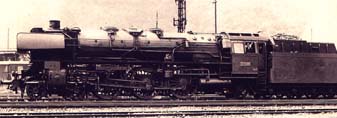BR 01.10
When the Deutsche Bundesbahn is founded in 1949 they have at their's disposal 54 steam engines of the series BR 01.10. The need for express train locomotives was high at that moment. Only the 01 1067 was immediately taken out of service because of extensive damage. The DB removed all streamline plates in 1949. The streamline plates had no advantage anymore, and the driving wheels were hardly accessible for maintenance staff. Moreover the streamline plates were making the steam engines more heavier and there were not much railway lines where they could run more than 130 km/h, considering the longer braking way and block sections for enough safety measures.
 | | BR 01 1088 without streamlined plates in Bw Hagen-Eckesey |
The steam engines were rebuilt and the streamline plates were removed and the locomotives got "Witte" smoke deflectors. In this new state the steam engines were hardly distinguished from the other BR 01 steam engines. You could recognise the BR 01.10 when you look to the water heater which is located under the door of the smoke box.
Until the beginning of the fifties the steam engines were maintained in the Bw's of Bebra, Hagen-Eckesey, Kassel and Paderborn. In Paderborn all locomotives BR 01.10 were exchanged in April 1952 against BR 03.10 locomotives from Offenburg.
The steam engines which were located in Baden were running together with the BR 01 steam engines in the same schedule of F and D trains on the line along the river Rhine on the relation Basel Badischer Bf-Hannover-Würzburg.
Because of the high load of the boilers, which were less durable for ageing than they thought, the boilers exhibited symptoms of fatigue. The used steel St 47K got little cracks near the smoke box, which was caused by the high temperatures. In November 1953 the first steam engines 01.10 were getting new boilers, the first steam engines with a new boiler was the 01 1052. The last steam engine got his new boiler in Oktober 1956, this was the 01 1082. The new boilers, built by Henschel, could handle higher loads than the old boilers. Steam engine 01 1095 was a curiosity, these had got a new boiler in 1953 but this boiler was exchanged in March 1962 for a test boilers. The AW Braunschweig wanted to test this new boiler, and therefore provided the 01 1095 with a new boiler.
Mid 1956 steam engine 01 1100 was the first express train steam engine with an oil firing installation. After an extensively testprogram, 33 steam engines BR 01.10 were provided with a new oil tender and were rebuilt to oil burning in 1957/58. Together with the BR 10 the oil burning steam engines were the strongest steam engines of the DB. The oil burning steam engines were mainly stationed in the Bw's Kassel and Osnabrück. In 1968 the steam engines were moved out of Osnabrück to Hamburg, where they were running trains from and to Westerland until 1972.
Because these steam engines were deliverd at the start of the second world war they were relatively young so they had their flourish in epoch III, while they were originally DRG steam engines.
| Axle layout: |
2'C1'h3 |
| In service: |
1939 |
| Diameter driving wheels: |
200 cm |
| Diameter carrying wheels: |
100 cm/125 cm |
Lengte over de buffers
(met tender 2'3 T38 St): |
24,13 m |
| Top speed: |
140 km/h |
| Power: |
2400 pk/hp |
| Boiler pressure: |
16 bar |
| Weight: |
114,3 t |
|
